| Previous :: Next Topic |
| Author |
Message |
Eric Gilbertson
Member


Joined: 04 Jul 2018
Posts: 188 | TRs | Pics
Location: Seattle |
Mt St Helens Survey
Oct 17 and Oct 20, 2023
Eric Gilbertson
Summary of Results: Elevation 8,321.1ft +/-0.2ft. Summit is losing elevation at rate of 4 inches/year. Removed from WA Top 100 List
Link to up-to-date WA Top 100 list: https://docs.google.com/spreadsheets/d/1gYaBTa32bLfXiQFrcpTJ58KjO1HIAEEMBDrttHFxUOg/edit#gid=0
Mt St Helens is one of the five volcanoes in Washington, and used to be the fifth tallest peak in the state at 9,677ft. On May 18, 1980 it erupted, reducing its elevation to 8,365ft. Since then it has been gradually losing elevation as the loose summit rocks and ash have eroded away. Based on the most recent Lidar surveys it was tied for number 100 on the Washington Top 100 Peaks list, the list of the 100 tallest peaks in Washington.
 On the summit on the Oct 17 survey attempt (too snowy, so only upper bound measurement)  The route 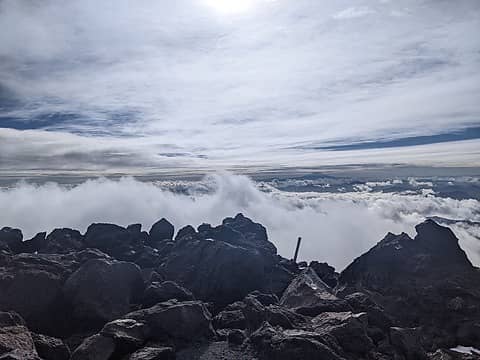 Hiking up above the clouds Tuesday morning  Summit snow conditions Oct 17 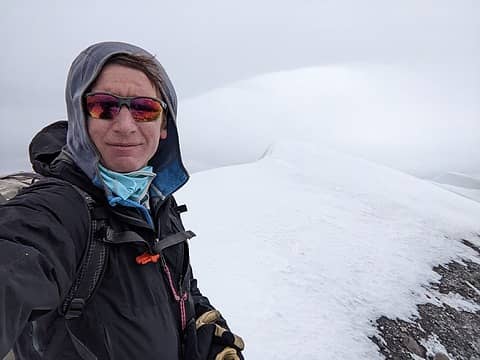 Near the summit Oct 17  Summit ridge conditions Oct 17 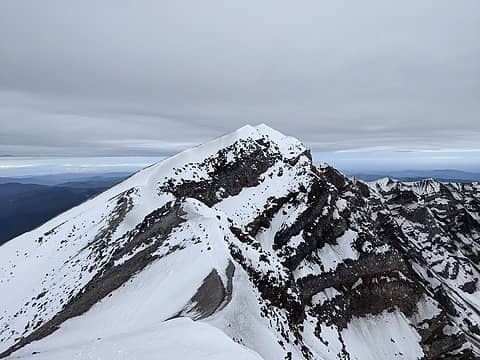 Looking back at the summit 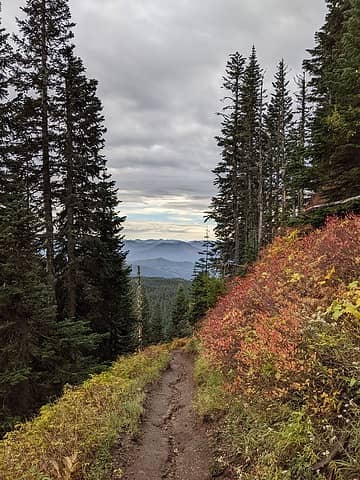 Hiking back down  Hiking up Friday evening 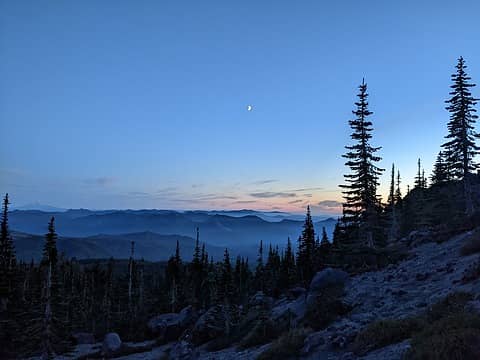 Sunset Friday eve 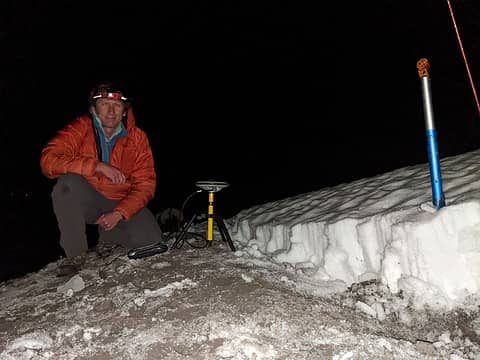 The GPS set up on the summit  The setup on the summit, looking to the east 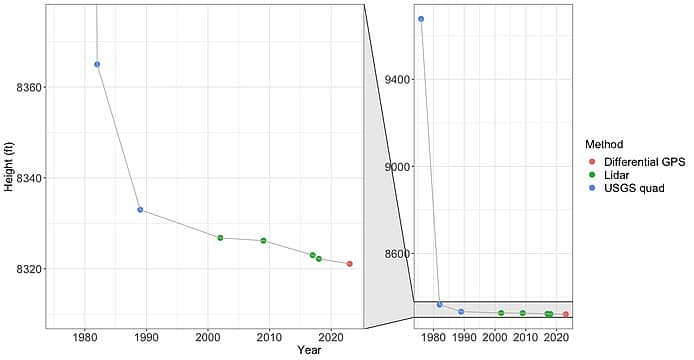 Plot of summit elevation measurements 1979 - 2023 (plot by Katie) 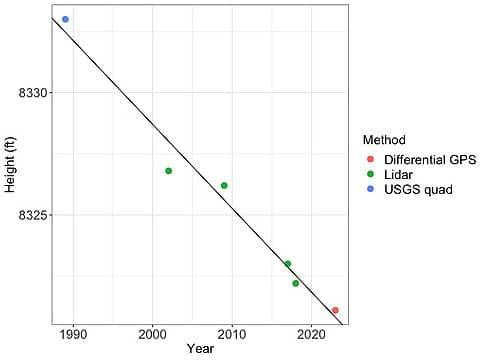 Summit elevation measurements 1989-2023 with linear fit (plot by Katie).
 brokein2, Michael Lewis, Now I Fly, Nancyann, call-151, wallorcrawl, williswall, JasonK806, zimmertr, rubywrangler, Scramblin Rover, RichP, John Mac, Alpine Pedestrian, kw, IanB, jaysway, awilsondc, LukeHelgeson brokein2, Michael Lewis, Now I Fly, Nancyann, call-151, wallorcrawl, williswall, JasonK806, zimmertr, rubywrangler, Scramblin Rover, RichP, John Mac, Alpine Pedestrian, kw, IanB, jaysway, awilsondc, LukeHelgeson
 brokein2, Michael Lewis, Now I Fly, Nancyann, call-151, wallorcrawl, williswall, JasonK806, zimmertr, rubywrangler, Scramblin Rover, RichP, John Mac, Alpine Pedestrian, kw, IanB, jaysway, awilsondc, LukeHelgeson brokein2, Michael Lewis, Now I Fly, Nancyann, call-151, wallorcrawl, williswall, JasonK806, zimmertr, rubywrangler, Scramblin Rover, RichP, John Mac, Alpine Pedestrian, kw, IanB, jaysway, awilsondc, LukeHelgeson |
| Back to top |
  
|
 |
Bosterson
Member


Joined: 12 Sep 2019
Posts: 294 | TRs | Pics
Location: Portland |
| Eric Gilbertson wrote: | | Interestingly, all the data from 1989-2023 show a very linear trend in elevation loss (R-squared value 0.98 from an ordinary least-squares regression). The summit is consistently losing 0.34ft/year (4 in/year). |
That's very interesting. Do you have thoughts about why that would be happening? Since the "summit" is now just a highpoint on the rim, and since the rim is so heavily corniced every winter, could this be from solids getting embedded in the snow and then melting down into the crater?
This is an xkcd level nerd question, but I would love to see someone do the math on how long it would take for the crater to "fill in" if 1/3 of a foot of dirt is being lost annually at every point around the rim (this surely isn't happening equally) - and how short the remaining mountain would be at that point. 
Go! Take a gun! And a dog! Without a leash! Chop down a tree! Start a fire! Piss wherever you want! Build a cairn! A HUGE ONE!
BE A REBEL! YOU ONLY LIVE ONCE!
(-bootpathguy)
 Eric Gilbertson Eric Gilbertson
Go! Take a gun! And a dog! Without a leash! Chop down a tree! Start a fire! Piss wherever you want! Build a cairn! A HUGE ONE!
BE A REBEL! YOU ONLY LIVE ONCE!
(-bootpathguy)
 Eric Gilbertson Eric Gilbertson
|
| Back to top |
  
|
 |
altasnob
Member


Joined: 29 Aug 2007
Posts: 1418 | TRs | Pics
Location: Tacoma |
 |
altasnob
Member
|
 Tue Oct 24, 2023 7:07 am |
|
|
| Bosterson wrote: | | I would love to see someone do the math on how long it would take for the crater to "fill in" if 1/3 of a foot of dirt is being lost annually at every point around the rim (this surely isn't happening equally) - and how short the remaining mountain would be at that point |
Have to take into account the crater dome growth as well. Maybe someday the dome can stick up past the crater rim and St Helens can regain its top 100 status.
 Eric Gilbertson, zimmertr, jaysway Eric Gilbertson, zimmertr, jaysway
 Eric Gilbertson, zimmertr, jaysway Eric Gilbertson, zimmertr, jaysway |
| Back to top |
  
|
 |
Eric Gilbertson
Member


Joined: 04 Jul 2018
Posts: 188 | TRs | Pics
Location: Seattle |
| Quote: | | Do you have thoughts about why that would be happening? |
I agree one reason is because the north face is so steep and loose and that's where the cornices form. In the spring/summer when the snow melts off I bet it brings rocks down with it. Also, I've heard the volcanic ash up there can get blown off with all the wind. The combination must add up to 4 in/year.
I'm amazed it's so consistent at 4 in/year, though. That's a very linear trend with six independent measurements. It must be consistent rock quality over depth and very similar weathering every year.
|
| Back to top |
  
|
 |
williswall
poser


Joined: 30 Sep 2007
Posts: 1968 | TRs | Pics
Location: Redmond |
Your surveys are extremely interesting; I enjoy reading these reports very much.
|
| Back to top |
  
|
 |
Gimpilator
infinity/21M


Joined: 12 Oct 2006
Posts: 1684 | TRs | Pics
Location: Edmonds, WA |
If volcanic forces can cause growth, can the reverse, a lessening of pressure, cause gradual recession?
The title of this report made my heart sink a little. Better to know the truth, but this particular volcano is so interesting and significant due to the eruption, its a shame that it fails the cutoff. Still appreciate the information and respect the drive to find the answer.  
|
| Back to top |
  
|
 |
Michael Lewis
Taking a nap

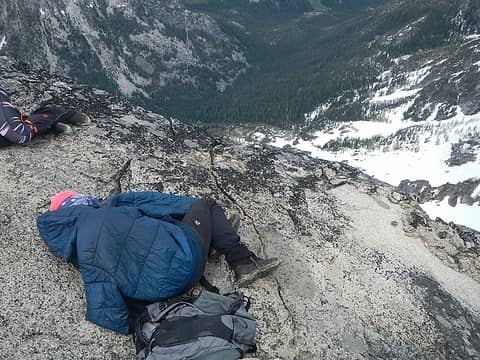
Joined: 27 Apr 2009
Posts: 629 | TRs | Pics
Location: Lynnwood, WA (for now) |
I saw on geology hub that according to USGS Mt St Helens is showing possible signs of the shallow magma chamber 6 km down filling which could change the overall height in the near future. It would be interesting if these measurements indicate anything towards that or could be taken again a year or two from now to see if it resulted in deformation incline or decline. P.M. if you'd like a sherpa.
Anyways, it's cool to see your mission unfold here over wild places we are nostalgic for. Your tenacity is a compelling read. Thanks Eric! May your pilgrimage continue to provide enticing data!
 Eric Gilbertson Eric Gilbertson
 Eric Gilbertson Eric Gilbertson |
| Back to top |
  
|
 |
Eric Gilbertson
Member


Joined: 04 Jul 2018
Posts: 188 | TRs | Pics
Location: Seattle |
| Quote: | | It would be interesting if these measurements indicate anything towards that or could be taken again a year or two from now to see if it resulted in deformation incline or decline. P.M. if you'd like a sherpa. |
I could probably be convinced to take another measurement next year. That would be interesting to keep getting more data. I could definitely use help hauling gear up!
|
| Back to top |
  
|
 |
|
|
You cannot post new topics in this forum
You cannot reply to topics in this forum
You cannot edit your posts in this forum
You cannot delete your posts in this forum
You cannot vote in polls in this forum
|
Disclosure: As an Amazon Associate NWHikers.net earns from qualifying purchases when you use our link(s). |